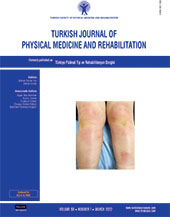Effect of task-oriented training on pain, functionality, and quality of life in rheumatoid arthritis
2 Department of Physical Medicine and Rehabilitation, University of Health Sciences, Bakırköy Dr. Sadi Konuk Training and Research Hospital, Istanbul, Turkey
3 Department of Physiotherapy and Rehabilitation, Istanbul Medipol University, Istanbul, Turkey DOI : 10.5606/tftrd.2022.6666 Objectives: The aim of this study was to demonstrate additional effects of task-oriented training (TOT) in patients with rheumatoid arthritis (RA) regarding pain, dexterity, muscle strength, and ability to perform activities of daily living (ADLs) within five weeks.
Patients and methods: Between June 2016 and February 2018, a total of 46 female RA patients (mean age: 51.17±7.9 years; range, 29 to 68 years) who were volunteer for participating in the study were randomized into two groups as follows: conventional exercise group (Group 1) and conventional + TOT group (Group 2). The exercises of Group 1 included passive range of motion (PROM), isometric grip strength exercises, and mobilization of metacarpophalangeal, proximal interphalangeal, and distal interphalangeal joints. In Group 2, in addition to conventional exercises, the patients completed an exercise program consisting of washing their faces, using forks, drinking water from a glass, sitting up, and putting on a shirt. Exercises were performed twice a week for a five-week period. Before and after the exercise programs, hand grip strength was assessed with a Jamar hand dynamometer, hand dexterity with Nine Hole Peg Test (NHPT), pain with Visual Analog Scale (VAS), and ADLs with Health Assessment Questionnaire (HAQ) and Duruöz Hand Index (DHI).
Results: There was no significant difference in NHPT and Jamar in both groups (p>0.05). Although a significant decrease was observed within the groups in VAS and HAQ scores before and after the exercise programs in both groups (p<0.05), no significant difference was found between the groups (p>0.05). The DHI showed a significant improvement in Group 2 and a significant difference was observed between the two groups (p<0.05).
Conclusion: This study shows that exercise programs may be beneficial in alleviating pain and performing daily activities. Also, adding task-oriented training to a program may facilitate ADLs in RA patients.
Keywords : Hand therapy, rheumatoid arthritis, task-oriented training

















